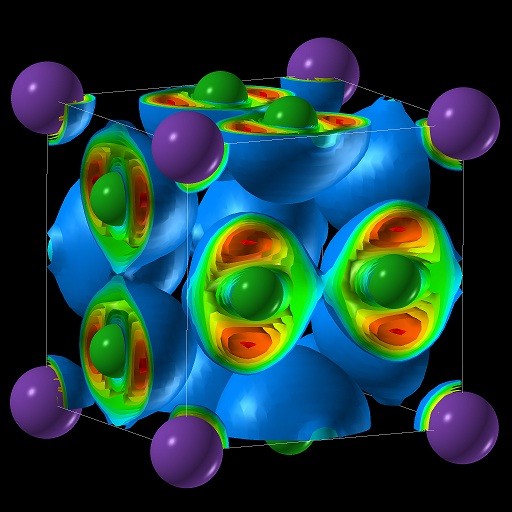Scientists turn table salt into forbidden compounds that violate textbook rules
January 20, 2014
A sample of NaCl3, which was considered 'forbidden' in classical chemistry (Photo: Alexander Goncharov)
In the field of exotic new materials, we've examined one of the strongest ones and another declared to be impossible; scientists now report creating "forbidden" materials out of ordinary table salt that violate classical rules of chemistry. Not only does the development challenge the theoretical foundation of chemistry, but it is also expected to lead to the discovery of new exotic chemical compounds with practical uses and shed light on the deep interiors of planets.
The international team of researchers led by Artem R. Oganov, a Professor of Crystallography at Stony Brook University, predicted that taking table salt and subjecting it to high pressure in the presence of an excess of one of its constituents (either chlorine or sodium) would lead to the formation of totally unexpected compounds. In spite of salt being one of the most thoroughly studied chemical compounds out there, the researchers predicted the formation of compounds forbidden by classical chemistry, such as Na3Cl and NaCl3. Their predictions were proven by subsequent experiments.
"Sodium has one electron in its outermost shell, and chlorine has seven," Weiwei Zhang, the lead author, a Professor of Physics at China Agricultural University and visiting scholar at Oganov's lab, tells Gizmag. "When sodium meets chlorine, sodium would like to give away an electron and chlorine wants to take one according to the Octet rule. Since one Na can supply only one electron to one Cl, the only possible combination of these atoms in a compound is 1:1, rocksalt NaCl. Take NaCl3 as an example, when you try to satisfy three Cl by one Na, there is no way to distribute electrons according to this rule. So NaCl3 is forbidden in the classical frame of chemistry."
In addition to NaCl3, the team has predicted other new "crazy" compounds, such as NaCl7, Na3Cl2, Na2Cl, and Na3Cl, based on a sophisticated algorithm developed by Oganov and his students involving quantum-mechanical calculations. The experiment verified their prediction that these exotic materials would be thermodynamically stable at high pressures. Their research opens up the way to successfully create and stabilize a huge number of compounds previously considered to be forbidden.
"They are 'forbidden' at ambient pressure, but the situation changes at high pressures," explains Alexander Goncharov, a Senior Staff Scientist at the Carnegie Institution of Washington and a key team member, responsible for the experimental confirmation of Zhang's and Oganov's predictions. "Pressure stabilizes new compounds and changes rules of chemistry we are used to at ambient pressure. These materials violate textbook chemistry at ambient pressure, but they do not violate any laws of physics, or more general chemistry rules at high pressures. The only trouble is that these more general rules still remain to be discovered."
Most of what we know about textbook chemistry only applies to ambient conditions, or the default conditions that one normally finds on the surface of the Earth, says the team. So it's entirely possible that what's forbidden on the Earth's surface under ambient conditions, becomes possible when things become more extreme, or in the presence of high energy that causes energy balances to shift, they claim. More than just broadening existing views, the researchers anticipate that it will start a revolution, or at least a new chapter in chemistry.
"We have found not just several sodium chlorides, but a whole new class of compounds, which are formed under pressure and to which standard chemical rules do not apply," Oganov tells us. "Now we need to formulate rules that apply to such compounds, explore their properties and possible applications."
Given how many weird compounds they were able to create with ordinary table salt, the team expects that it'll be possible to discover and create more new ones by subjecting other materials to high pressures, too. When created, these new materials could have many unusual properties with practical uses. For instance, Na3Cl is a two dimensional metal, made of layers of pure sodium and salt that can conduct electricity. The salt layers act as insulators while the sodium layers act as conductors. They've predicted other exotic materials that can be made in large quantities and patented their possible use.
All the materials they've created so far are stable only at high pressures and transform back into their initial states when the pressure is lowered. The next step, the team says, is to get them to be stable at ambient pressure by manipulating factors like material parameters, dimensionality, reaction kinetics and more. Further experiments, that start out with compounds other than NaCl, are expected to yield insights into the kind of compounds that may exist in planetary cores.
"For example, with Mg-O (Magnesium Oxide), which comprises a large part of mantles of terrestrial planets, and probably also of cores of gas giant planets, we found totally unexpected compounds (including Mg3O2) that might exist within some planets in large quantities," says Oganov.
Their paper on the research was recently published in the journal Science.
Source: Stony Brook University

